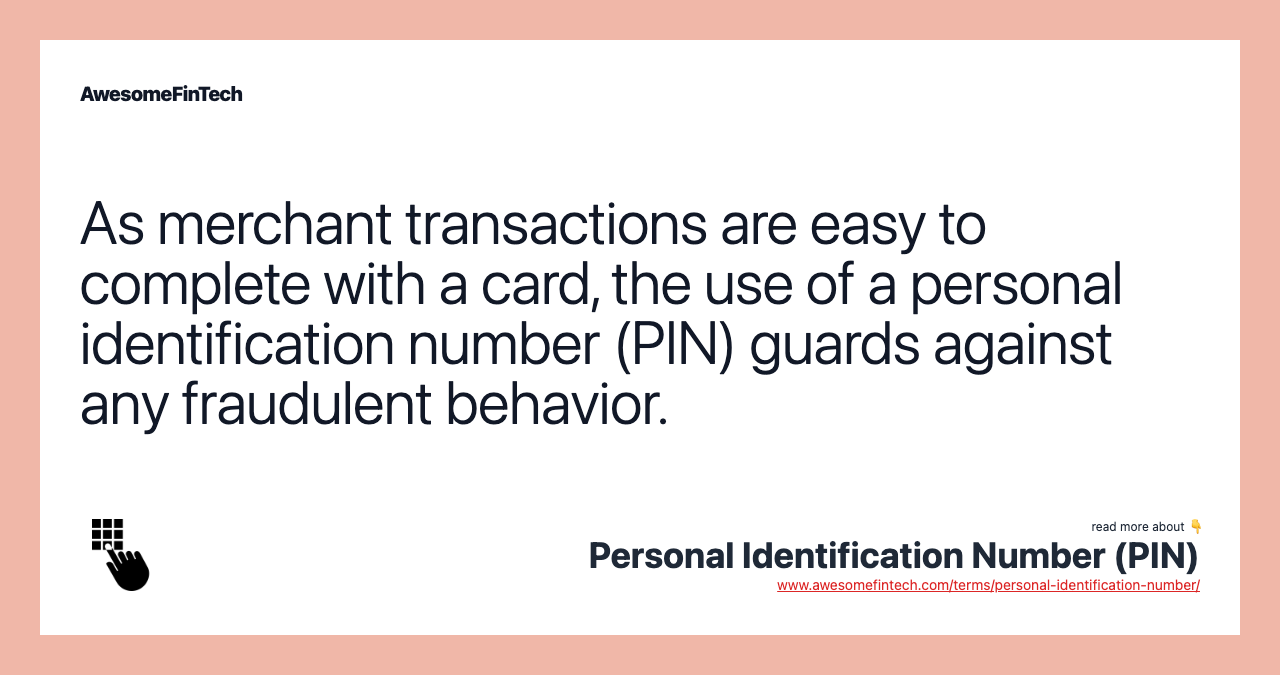Personal Identification Number (PIN)
A personal identification number (PIN) is a numerical code used in many electronic financial transactions. When a person is issued a debit card, they are required to choose a unique personal identification number (PIN) that they will need to enter every time they wish to withdraw money from an ATM and oftentimes when they make payments at various merchant stores. A personal identification number (PIN) is a numerical code issued with a payment card that is required to be entered to complete various financial transactions. Debit cards are the most common instance in which individuals will need to use a personal identification number (PIN), primarily when they withdraw money from their bank account. The core purpose of a personal identification number (PIN) is to provide an additional layer of security to the electronic transaction process.

What Is a Personal Identification Number (PIN)?
A personal identification number (PIN) is a numerical code used in many electronic financial transactions. Personal identification numbers are usually issued in association with payment cards and may be required to complete a transaction. The purpose of a personal identification number (PIN) is to add additional security to the electronic transaction process.






Understanding a Personal Identification Number (PIN)
Personal identification numbers provide additional security on an account and are most commonly used with debit cards linked to a person’s bank account. When a person is issued a debit card, they are required to choose a unique personal identification number (PIN) that they will need to enter every time they wish to withdraw money from an ATM and oftentimes when they make payments at various merchant stores.
As PINs are like passwords, they are also used in many other instances, such as home security and mobile phones. A PIN is basically any numerical method used to verify an individual's identity.
Card Security and Personal Identification Numbers (PINs)
Personal identification numbers (PINs) usually range from four to six digits and are generated by the issuing bank through a coding system that makes each PIN unique, or are chosen by the account holder themself. Typically, a PIN is issued to a cardholder by mail separately from the associated card or punched in at a local branch when opening an account in person.
When choosing a PIN, it is recommended to choose one that will be difficult to guess but also easy for the account holder to remember. Short, basic PINs are advised against, such as using "123" or numbers that would be easy to guess in instances of fraud; common information, such as an account holder's birthday, marriage anniversary, or Social Security Number. It is crucial that account-holders be cautious about sharing or disclosing their personal identification number to prevent unwanted access to their bank accounts.
Electronic Transaction Processing and Personal Identification Numbers (PINs)
Electronic transactions with merchants are slightly more complex than a standard ATM transaction. Merchant transactions will involve the merchant, the merchant acquiring bank, the processing network, and the issuing bank. Therefore, the use of a PIN number can help make transactions more secure by requiring an additional layer of identification from the buyer.
PINs are commonly required as the final step in a payment, giving a merchant the approval to process a card for payment. A PIN is usually only required by the merchant at the point of sale as opposed to being required for online purchases. Once approval is given to process a card, communication is sent to the merchant acquiring bank, which facilitates the settlement of the payment.
Once payment communication is designated to the specified processing network, the processing network can then contact the cardholder’s issuing bank. The issuing bank does additional security checks on the transaction to ensure that it is not fraudulent. They also confirm that the funds are available in a cardholder’s account to cover the payment.
The issuing bank takes additional security precautions when receiving a transaction communication from a merchant in order to ensure the safety of the transaction. Once confirmed by the issuing bank, communication is sent through the processor to the merchant acquiring bank who notifies the merchant and begins settlement on the transaction.
Related terms:
Acquirer
An acquirer is a company that acquires rights to another company or business relationship through a deal. read more
American Express Card
An American Express card is an electronic payment card branded by the American Express Company. read more
Checking Account
A checking account is a deposit account held at a financial institution that allows deposits and withdrawals. Checking accounts are very liquid and can be accessed using checks, automated teller machines, and electronic debits, among other methods. read more
Chip Card
A chip card is a plastic debit card or credit card that contains an embedded microchip. The chip encrypts information to increase data security. read more
Debit Card
A debit card lets consumers pay for purchases by deducting money from their checking account. Learn how debit cards work, their fees, and pros and cons. read more
EMV
EMV Chip is a global standard relating to integrated circuit cards, point-of-sale terminals, and automated teller machines, currently managed by EMVCo. read more
Fraud
Fraud, in a general sense, is purposeful deceit designed to provide the perpetrator with unlawful gain or to deny a right to a victim. read more
Mastercard
A Mastercard is any electronic payment card that uses the Mastercard network for processing transaction communications. read more
Payment Gateway
A payment gateway is the front-end technology that reads payment cards and sends customer information to the merchant acquiring bank for processing. read more
Point of Sale (POS)
Point of sale (POS) refers to the place where customers execute payments for goods or services. POS systems provide companies with sales and marketing data. read more